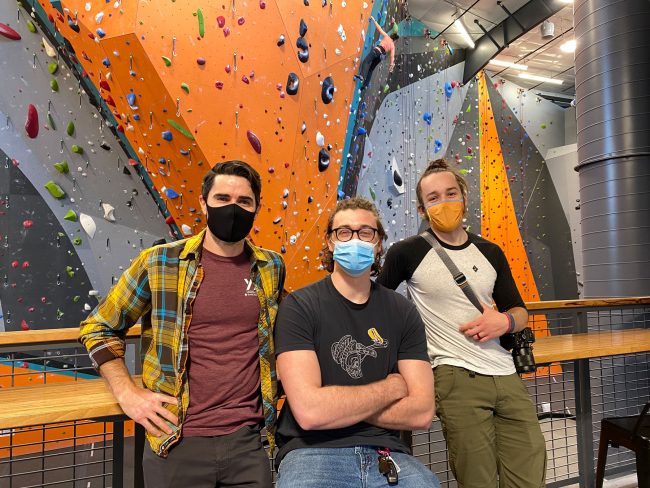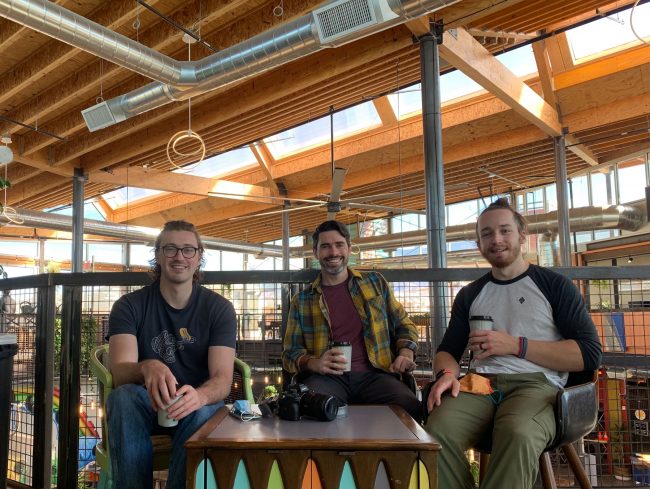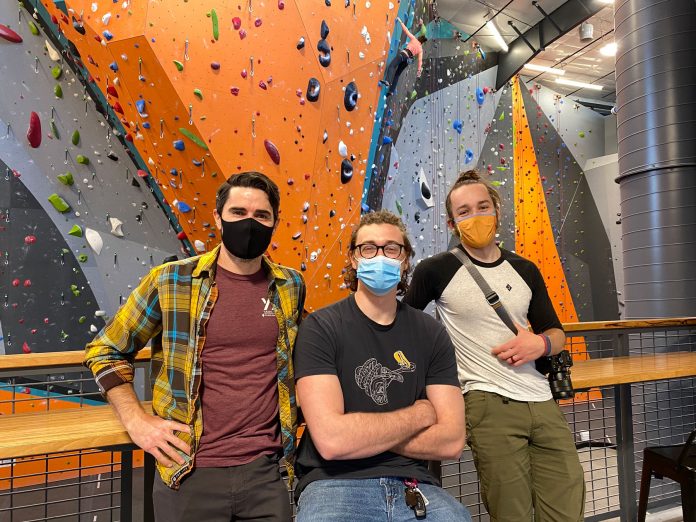One of the most exciting developments of the past few years—with the evolving nature of digital marketing, the popularity of YouTube, and the increasing availability of good software—is the increased presence of gym videos. Some climbing gyms utilize homemade (or home-produced) videos for safety and belay certification purposes; other gyms regularly release “Climb of the Week”-type clips on social media to engage with their respective communities. And over the last few months, we’ve taken notice of the videos coming out of Stone Age in New Mexico. Recent offerings such as an alien invasion (“Zorg from Mars”) take the Climb of the Week video concept to another level, and blend gym climbing with animation, music, even sound effects and costumes.
To get the full story behind Stone Age’s videos and hear whether other gyms could be doing similarly elaborate storytelling, we chatted with Jeremiah Curtis, Aaron Stromberg, and Ben Lane. The three creators typically split the animation, editing, and directing duties for Stone Age, and in the process, might single-handedly be inspiring other gyms to think outside the box with video.

CBJ: Can you briefly tell me your background—each of you—and how you all came together at Stone Age?
CURTIS: I have been climbing in New Mexico for roughly a decade at this point, with about five of those years climbing competitively. Soon after, I started coaching with Aaron [Stromberg]. About three years ago, I started routesetting—which really opened my eyes to this more creative and artistic side of climbing. On the other hand, I started editing and filming videos around age 10 with my dad. We’d make music videos, skits, and I remember making a 45-minute Lego film on iMovie. Since then I have been mostly experimenting and making a bunch of random personal projects. Ben [Lane], Aaron, and I started making these more dramatic videos recently thanks to the increased enthusiasm throughout Stone Age’s community. If it weren’t for the support and the community’s psych, then I don’t think we would have been able to build this momentum.
STROMBERG: I grew up in New Mexico and would climb with my father and brother outdoors—partially because there wasn’t a climbing gym at that point, but mostly because it is beautiful. One gym opened and we would climb there occasionally, but my family became more serious about climbing when the first Stone Age location opened. My older brother joined the competitive team, and he taught me more advanced climbing techniques. I started working for Stone Age and quickly started coaching. I’ve been a USA Climbing coach for 15 years, and have worked at Stone Age for a little longer than that. In high school I loved making skate videos with my friends and made a bunch of comedies like the ones we’ve made for Stone Age. Jeremiah [Curtis] and I have been friends for a long time, since he joined the climbing team while I was coaching. Ben started working at the gym a little more recently, and has been awesome to work with. He’s a really cool guy, and while we all have different skills to offer it’s been fun working as a team.
LANE: I have been climbing for about a year now and have, as so many do, completely fallen in love with the sport. I became a part of the Stone Age team a little over eight months ago, joining as a customer service representative. Jeremiah, who I met a few years ago in a college film class, played a big part in my initial involvement with the creative team by advocating for my abilities as a video editor. This has created a lot of opportunities for me to do more for the gym, despite being so new to the sport. Since then I have been lucky enough to work with both Jeremiah and Aaron on a number of fun projects, all of which I have learned a lot from. I am very excited to see where the future takes us.
CBJ: A lot of other gyms do “Climb of the Week” videos, but many only show the climb itself. The videos you all do for Stone Age actually tell a story…alien invasion, a Western, etc. Where do these ideas come from?
CURTIS: Story is king. It doesn’t have to be serious, but there should be a story. Even with our more simplistic weekly videos, we try to incorporate some sort of story for the viewer to follow. Not everyone who sees these videos are climbers, but they could be! I think that adding these stories adds more value than just beta for the climb. As for our bigger ideas like the recent Alien Invasion, we give ourselves more time to brainstorm something feasible. New Mexico has always been associated with aliens so we wanted to use that to play on the local culture. I think finding subtle ways to make a video stand out is really helpful and stories do that really well. If you come up with a fun idea, then ask your team how you can tell a quick 1-2-minute story from that idea.
STROMBERG: I think a big part of our videos is to just have fun with it. A while back my friend Curran had a Valentine’s Day post for Momentum Climbing Gym of him wearing a Cupid outfit and it just cracked me up. That’s what I wanted to share with our community. With this year being so rough, a little joy goes a long way. While it’s good to have some more serious, straightforward videos, I think it’s also important to not take yourself too seriously. In December, we made a goofy Grinch video and people liked it. Then our friend Carlos suggested doing a Western. I knew filming holds on the wall would be a fun and easy effect, and the story just came from there. Of course, Carlos had to be one of the cowboys. Like Jeremiah said, the alien theme is a classic New Mexico trope and had some fun potential, so we just ran with that idea as well. We’ve got a bunch of other ideas up our sleeves but you’ll have to wait for that.
CBJ: How much planning and pre-production goes into the videos you do for Stone Age? Can you walk me through the process/timeline of creating one?
CURTIS: For the larger projects we typically try to give ourselves at least one month to plan, film, and edit the video. We meet weekly to brainstorm ideas and make sure we are staying on track with all our projects. Meeting up for an unstructured brainstorming session is really where these ideas come to fruition. Our themed Climb of the Week videos are typically a big crunch though. We have to plan with the routesetting team on when we can film the week’s new boulder problems. That typically means we are shooting on a Thursday or Friday with needing to turn it around by the following Monday. Since we give ourselves time to plan though, we can just follow a rough script…which helps the filming go smoother.
STROMBERG: Jeremiah has been working really hard on the climb of the week videos and does a great job with them. We all do a few different jobs around the gym, but Jeremiah does most of the week-to-week videos and then brings Ben and myself in to help with the larger videos. As far as pre-production, we also have to get the costumes and props together and that takes a little time.
CBJ: How hard is it to add the animation?
STROMBERG: I think it’s safe to say that Zack Snyder would be jealous of our visual effects. Ben may be better suited to answer this question because he did the editing, but stop-motion isn’t too hard, and with the help of Adobe Premiere, you can remove a contrasting background. We know our limitations with our visual effects, and we lean into it. The rough and corny effects come across as fun and lighthearted. It all fits into the feeling we want to convey.
LANE: Though animation, especially stop-motion, is typically a super time-consuming process, we utilized a somewhat rudimentary approach for this video that ended up saving us a ton of time. Aaron and I drew the artwork for the UFO, portal, explosion etc. keeping in mind that we wanted it all to look as cartoonish as possible. Then we took a series of pictures of each drawing laid on top of a sheet of green paper. I then imported all the pictures into Premiere and simply removed the green background. In total, the process probably took a total of three hours. That may seem like a lot of time for just a couple seconds of animation, but I believe it was totally worth it considering how much dimension and aesthetic value it adds to the video.
CBJ: Can you tell me what specific gear you are using for the film shoots?
CURTIS: I like this question a lot because we actually just changed our setup. Before Alien Invasion [ie. Zorg from Mars], we were using an iPhone XR with a DJI phone gimbal. The Western and previous videos were shot entirely on that setup. Now we are using my personal setup that includes a Sony A7Siii, DJI RSC2 gimbal, and a Deity Shotgun Microphone. The newer gear has been great, but I am very thankful I spent so much time shooting on an iPhone. The simplicity of the iPhone setup lets us focus more on the story, mise-en-scène, and cinematography. What’s funny is that I bet most viewers haven’t even noticed the change in our setup either. At the moment, we don’t use any extra lighting besides the gym’s lighting and natural light. I would be psyched on working with more lighting down the road, but we want to expand only at the rate that is sustainable. I guess what I am trying to say is that if you have a phone, you can make an awesome video. Gimbals tend to help too.
STROMBERG: Just like [Jeremiah Curtis] said, if you want a professional-looking video, you should get a gimbal. They’re inexpensive and really make the videos cleaner.
CBJ: What’s the hardest thing in a gym climbing video shoot?
STROMBERG: The hardest thing about filming is finding time to do them. Fortunately, we’ve been able to address this issue by working as a team. On one of our recent employee highlight videos Ben filmed the canyoneering section when neither Jeremiah or myself were available. Those shots really brought that video together, and if it weren’t for Ben’s availability, that video would not have been as cool as it is.
CURTIS: I agree, finding the time to plan, film, and edit these videos can be rather challenging. However, being able to bring a team together and share the workload has really helped us with this challenge. Teamwork really is a powerful tool when it comes to filmmaking, and I think we have really leaned into that.

CBJ: Is it safe to say most gyms have not yet realized or utilized the full capability of video content with their marketing and promotion?
CURTIS: Most definitely. If you look around, almost everything is video. We have more moving pictures streaming into our eyes than ever before. That isn’t going to change, and I think that climbing gyms should take note of that—especially as the industry is trying to engage with the community to pull out of 2020. Videos are engaging, which helps build community, and that is exactly what we need to help the industry gain momentum again.
STROMBERG: Jeremiah is totally right. Our best marketing content is video, and if you’re not making videos, you’re not getting the attention you deserve.
LANE: Climbing being the amazing and visually stimulating sport that it is, I think that there really is no limit to the interesting video content that gyms could be producing.
CBJ: In that case, can you offer any video production tips or advice for other gyms that might want to up their game?
CURTIS: Pick up that phone and start shooting. Make a short story/narrative and see what you can put together. If that doesn’t stick, then keep shooting because that’s the best way to learn those skills. Consistency really helps, so make sure that your crew isn’t overwhelmed. Start small, then keep expanding so that no one gets burned out and the psych remains.
STROMBERG: I would recommend keeping it simple, get a gimbal and have fun with it. Something you don’t see in the videos is how much fun our community has while we shoot the videos. They want to take photos with us, ask us questions, and laugh with us. It’s been really awesome to see.
LANE: Don’t be afraid to experiment with new video techniques and try to mix mediums when possible. Videos can be so much more than the original footage that you capture; you can animate, play with color, sound, and get crazy with it.

John Burgman is the author of High Drama, a book that chronicles the history of American competition climbing. He is a Fulbright journalism grant recipient and a former magazine editor. He holds a master’s degree from New York University and bachelor’s degree from Miami University. In addition to writing, he coaches a youth bouldering team. Follow him on Twitter @John_Burgman and Instagram @jbclimbs. Read our interview Meet John Burgman, U.S. Comp Climbing’s Top Journalist.









